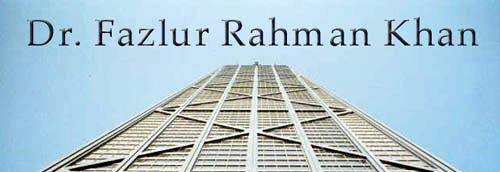| |

Professional Milestones
After completing undergraduate coursework at the Bengal Engineering College, University of Calcutta, Fazlur R. Khan received his bachelor’s degree from the University of Dacca in 1951 while placing first in his class. A Fulbright Scholarship and a Pakistani Government Scholarship subsequently enabled him to travel to the United States in 1952 where he pursued advanced studies at the University of Illinois, Urbana. In three short years Khan earned two masters’ degrees — one in structural engineering and one in theoretical and applied mechanics — and a PhD in structural engineering.

|
| | |
|
A Bangladesh postal stamp honors Fazlur Rahman Khan.
|
He received an Alumni Honor Award from the University of Illinois, Urbana (1972), an Honorary Doctor of Science from Northwestern University (1973), and an Honorary Doctor of Engineering from Lehigh University (1980).
In 1961, Fazlur Khan was made a Participating Associate in Skidmore, Owings & Merrill; in 1966 he became an Associate Partner and in 1970 a General Partner – the only engineer partner at the time.
In 1973 he was honored with the top accolade for an engineer in the United States, election to the National Academy of Engineering.
He was cited five times among "Men Who Served the Best Interests of the Construction Industry" by Engineering News-Record (for 1965, 1968, 1970, 1971, and 1979); and in 1972 he was named "Construction's Man of the Year."
He was posthumously honored with the International Award of Merit in Structural Engineering from the International Association for Bridge and Structural Engineering and a Distinguished Service Award from the AIA Chicago Chapter (both in 1982).
In 1983 the American Institute of Architects recognized Fazlur Khan's contributions with an AIA Institute Honor for Distinguished Achievement.
That same year he was honored with the Aga Khan Award for Architecture "for the Structure of the Hajj Terminal, An Outstanding Contribution to Architecture for Muslims," which was completed over the last years of his life.
The Structural Engineers Association of Illinois recognized his achievements with the John Parmer Award in 1987. The SEAOI also commissioned a sculpture in Fazlur Khan’s honor by the Spanish artist Carlos Marinas. The sculpture is located in the lobby of the Sears Tower.
In 1998 the city of Chicago named the intersection of Jackson and
Franklin Streets (located at the foot of the Sears Tower) “Fazlur R. Khan
Way.”
Other honors include:
- Chicagoan of the Year in Architecture and Engineering, Chicago Junior Chamber of Commerce (1970);
- Special Citation Award, American Institute of Steel Construction (1971);
- Wason Medal for the most meritorious paper, American Concrete Institute (1971);
- Thomas A. Middlebrooks Award, American Society of Civil Engineers (1972);
- Chicago Civil Engineer of the Year, Illinois Section, ASCE (1972);
- J. Lloyd Kimbrough Medal, American Institute of Steel Construction (1973); Khan was only the fifth recipient of AISC's highest tribute to professional achievement in the award's 35-year history;
- Alfred E. Lindau Award, American Concrete Institute (1973) "for outstanding contributions in advancing the art of reinforced concrete construction in high buildings";
- Oscar Faber Medal, Institution of Structural Engineers, London (1973);
- State Service Award, Illinois Council, American Institute of Architects;
- Ernest E. Howard Award, American Society of Civil Engineers (1977);
- G. Brooks Earnest Award, American Society of Civil Engineers, Cleveland Section.

|

|
|

